Life Rafts I have little space to stow a life raft on my 30-foot Baba. On my three trips to Bermuda, I rented a valise-packed raft, tied it down, and used it as a helmsman seat. For liability reasons, most life raft manufacturers oppose sitting on the raft, but cannot explain why it is an unsafe practice. I have read too many stories of life rafts being swept off deck mounts, plus, I do not have a good place for a deck 288 mount. In my view, there is no downside to a valise-packed raft, especially a vacuum-packed one from Winslow. I am considering one of theirs, and they will pack it to spec so I can fit it in a cockpit locker (on top of course). Most life raft makers officially support the valise for liability reasons. My only suggestion to Winslow is to include a meter of some type inside the vacuum packaging so that any moisture intrusion can be detected. Anyway, Winslow is the only way to go, I think, because of the vacuum pack and the custom pack. Alan D. Sugarman Framboise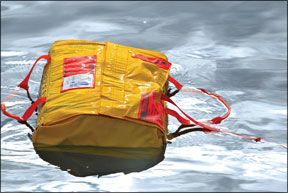
Annapolis, Md.
Practical Sailor
has long held that the best place for a life raft is in a dedicated locker. For the vast majority of boats the size of yours, a vacuum-packed valise life raft may be the only one that will fit into a standard lazarette or cockpit locker. It is encouraging to see that many more new boats are including dedicated life raft lockers, if only to meet International Sailing Federation (ISAF) standards. Likewise, more manufacturers are vacuum-packing their rafts, which allows better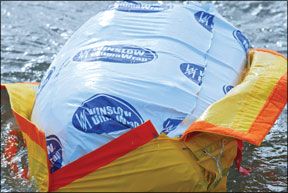
288
protection against moisture intrusion, or condensation, both of which can lead to life raft failure. Regarding vacuum packing: The method has gained the support of the ISAF, which prolongs the first service interval for a new vacuum-packed raft by one year. Typically, the ISAF requires every life raft to be fully inflated and inspected annually, but for new vacuum-packed life rafts, that service interval is extended to two years. It would be interesting to find out what percentage of vacuum packed rafts pass muster at their first two-year inspection.
from Winslow
In your
review of life rafts (April 2007), Practical Sailor said that the threaded mechanical connector, or “link valve,” that holds the required vacuum in the Winslow UltimaWrap was only finger tight and unscrewed easily. The proper spec is finger tight. While no problems have been reported in the field, to ensure it cannot be loosened, we have added Loctite to this step.Winslow has engineered a three-support-point system for those Winslows with a “boarding platform” to provide the same distribution of strength as on the Winslow with a “boarding ladder.”
Tube deformation during the towing test was more aptly due to the top-rated Cape Horn ballast system and the drogue, which would add significant stress to any life raft under tow. The likelihood of being towed is insignificant to the critical and often under-rated need for stability features like a heavy-duty drogue and ballast. This proved to be very true in our own testing during Tropical Storm Josephine in 1996.
The soft inflation has also been addressed. To ensure that proper cylinder size and gas fill is matched up with the life raft part number without fail, Winslow has developed an “automated fill station.” The fill station selects proper bottle size and fills each cylinder with the exact gas mixture of CO
2 and N2 required by Winslows specification manual. Unlike industry standards, this eliminates human error.Gerard J. Pickhardt
Winslow LifeRaft Co. President
www.winslowliferaft.com
Winslow also supplied
Practical Sailor with video and photos of a Winslow raft inflating in cold water temperatures (41.7 F). This supports Winslows claim that our experience with the Winslow life raft during testing (April 2007) was not the norm. The Practical Sailor tow test was meant to simulate loads on a life raft tethered to a drogue or boat during raft deployment.DSB life raft update
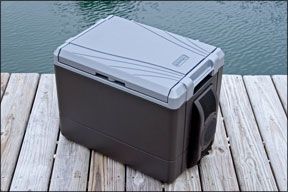
288
In early May, DSB finalized the last prototype tests for our four, six-, and eight-man DSB ISO rafts (container and valise packed).
As discussed in your article, we did have a problem with the pulling force on the container models painter lines: The painter had to make a “loop” from the operating head to the hole in the middle of the end of the upper container half. When we moved this hole in the container to the lower container half and placed it near the operating head, there were no problems whatsoever and no “loops.” Several rafts were modified this way and tested successfully. The pulling force is now well under the requirement of 150 Newton (33.72 pounds) and is on average around 140 Newton (31.47 pounds).
Erik Soendergaard
DSB Director of Marine
Products
www.deutsche
schlauchboot.de
Battery selection
Your latest article recommended a handheld VHF for survival equipment, and many of these radios use Li-ion rechargeable batteries. Because of their unique drawbacks, Li-ion batteries should not be used in this application. A charged Li-ion battery will lose 20 percent of its capacity per year regardless of the number of charge/discharge cycles.
Other rechargeables are not much better for survival use, while their capacity declines slowly with the number of cycles, they self-discharge just sitting around. A better choice is something like the Icom IC-GM1600 Survival handheld, which uses a non-rechargeable lithium battery, similar to those used in other emergency

107
electronics. Another choice is keeping a few sets of fresh Alkaline cells and appropriate battery trays in your ditch bag.
Tony Fassbind
MarTee
, Cobalt 25Via e-mail
Most major VHF manufacturers make optional alkaline battery packs for their handhelds, and thats what should be in the ditch kit. The crew can include a charged lithium-ion-powered handheld VHF in the ditch kit (or take the ships handheld with them), but be sure to have the optional alkaline battery pack and plenty of AA batteries. This was mentioned in our review of VHFs. Icoms technical support manager Rodney Grim had this to say: “Certainly if you get a Lithium-ion battery and never do anything with it, then in five years, it could be dead because of shelf life. Actually, this is a possibility with any rechargeable battery. And if you leave any battery dead long enough, one or more of the cells in the battery could reverse and thats the end of that battery.
In reality, Li-ion is great for life raft application because it has a relatively low self-discharge rate on the order of 1 or 2 percent per month. Our GM1600 survival craft radio uses the BP-234 lithium battery just for this reason. There is no rechargeable battery chemistry that has the shelf life of primary cell batteries (like alkaline), so if shelf life is a huge concern, go that route.”
Practical Sailor noted that although the GM1600 does have a charger, the owners manual clearly does not recommend it for life raft applications.Lighter-Plug Meltdown
I purchased a Coleman Powerchill 40. I had the unit for less than 24 hours before
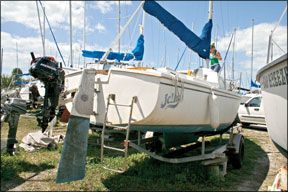
288
the DC plug adapter became so hot that it started to melt. The fuse was melted into the fuse holder and had not blown. I am glad that I was still at the dock and paying attention. If we had been out sailing for four or five hours, my guess is that it would have started a fire.
I returned the unit for a full refund and called Coleman. They were very nice and took the information for the disposition of the unit, but never asked any of my contact information. I am very disappointed in the customer service at Coleman.
Brian and Pat Yates
Hakuna Matata
, Catalina 30Via e-mail
We did not experience this with the Coleman Powerchill during our thermo-coolers tests (April 2007). It sounds to us like this unit was defective and drawing excessive amperage (a locked rotor in a bilge pump can have a similar effect) or there was a bad connection in the cigarette-lighter plug-socket connection that caused it to overheat. We operated all of these coolers for many hours with new, properly rated outlets and wiring, and did not have any issues.
The problem could be your plug. There are a lot of cheap cigarette-lighter sockets and plugs on the market, but even a high-grade connection of this type is not our first choice. As mentioned in last months article on compressor-driven portable fridges, replacing the lighter plug-and-socket connection with a common pin-and-socket Ancor union or similar marine-grade connection is an option, but this would make it hard to use the refrigerator in your car as well. In either case, it is important to see that the socket or connection are rated to carry the current these devices require, and wires are sized so that there is no more than a 3 percent voltage drop in the circuit.
Although the plugs on these devices are fused, lighter sockets should always be fused or protected with a properly sized circuit breaker. A thermal fuse like that in the Engel fridges we reviewed last month offers an extra measure of protection.
A Jelly Affair
A friend on my Catalina 22 discussion group posted the following:
“
Practical Sailor adopted a neglected 1974 Catalina 22 and its dilapidated trailer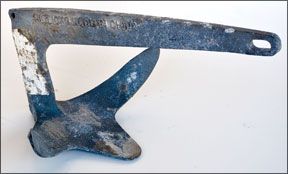
288
this month. Total price: $800. The boats name is
Jelly, and she is, in the truest sense, a fixer-upper…”Ive been there, done that, and am sailing the results. See:
www.chipford.com.Chip Ford
Chips Ahoy
, Catalina 22Marblehead, Mass.
We received a lot of mail regarding the newest addition to the test boat fleet,
Jelly, in need of some serious repair and refit. Anyone thinking about resurrecting a Catalina 22, or larger pocket-cruiser like the Balboa 26, which we review in this issue on page 7, should drop in on Chips website. It offers an inspiring-and sobering-look at the challenges and rewards in store.Anchor choices
I want to purchase a Claw-type anchor to complement my 35-pound Genuine CQR for my Ontario 32. I paid a premium for the CQR over a knock off, and I am wondering whether this was necessary (from a strength and performance point of view). The Lewmar Horizon 33-pound Claw is $100, and the genuine Bruce is in the $450 range. I asked a vendor at the Toronto boat show about this, and he said the question was foolish because the cleats would rip out of my deck before even a cheap knock-off Bruce would break or bend. My anchors will be my only insurance policy in the future. I value your opinion.
Richard Patrick
Rascal
, Ontario 32Windsor, Ontario
The Lewmar Claw did well in our most recent tests in mud and its price in that category is hard to beat. The main difference between the two anchors is that the Lewmar Claw is cast, while the original Bruce is drop forged. Cast metals are more brittle and generally inferior, and casting voids arent apparent until failure. Although weve had no reports of a Bruce-type anchor bending, even drop-forged anchors can bend before rode attachment points on the boat fail. We have photos somewhere of a pretzel-shaped CQR-type (not an original) that was stuck in a South Pacific reef during a blow, but this shank design is more susceptible to shear loading than the Bruce.
Bigger is always better, but theres a limit to what you can handle. Provided you have adequate all-chain rode, a 35-pound CQR-type is adequate insurance for the
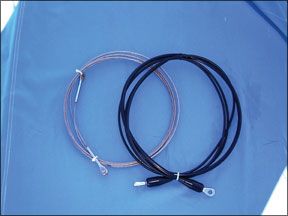
288
Ontario 32s design and displacement (about 10,000 pounds), and the 33-pound Claw will also serve as a good day or secondary anchor. Given the amount of corrosion in the Lewmar Claw used in our test, we are concerned about the durability of the galvanized zinc coating compared to the original Bruce anchors, and wed be interested in feedback from readers. The editor used a 45-pound genuine CQR and a 33-pound Bruce, both made in the United Kingdom, on his 12-ton, 30-foot ketch, and after 10 years of hard use, only the key points of abrasion-the tip, hinge pin, and shackle eye of the CQR, and the leading edges of the flukes on the less-used Bruce-showed signs of corrosion. Our five-year-old Lewmar Claw, which has seen some rough use, is more corroded than those anchors ever were, although it still has life in it.
Rigging Replacement
I am getting ready to replace the standing rigging on my 1973 Islander 36. When shopping for 1×19 316 wire, at West Marine, Defender, and pyacht.com, I have found radical differences in price. I am wondering whether all wire is the same, and how can I tell what quality wire I am buying?
Bill Knopf
Islander 36
Santa Cruz, Calif.
Stainless steel wire rope varies both in its corrosion resistance and the consistency of its mechanical properties. Product manufactured in the U.S. and Western Europe has earned a good reputation based upon quality control. Rigging wire manufactured in China has had a poor record, and pro riggers avoid the bargain-priced product.
The least corrosion-prone 1×19 rigging wire is made from 316 stainless steel alloy that contains a chromium-to-nickel ratio that lessens the likelihood of chloride-ion corrosion, which is prevalent in tropical climates.
This said, more often than not, its a swage terminal failure that results in rig damage or loss, and mid-wire failure is rare. Consequently, many sailors looking for cost-effective rigging replacement choose U.S.-manufactured 304 stainless steel wire and put up with the slight discoloration associated with lower grade, but stronger stainless alloy.
When comparison shopping, make sure that a low cost, too-good-to-be-true price doesn’t stem from an off-brand import that has seen little or no quality control, and make sure that just as much attention is given to the marine eye fittings at each end of the wire.
In your area, contributing editor Skip Allan is currently working on a project on high-modulus PBO rigging. He has used Buzz Ballenger at Ballenger Spars (
www.ballengerspars.com) for more than two decades. Buzz is based in Watsonville, Calif.Hatch/Window Scratches
Someone scuffed a vertical acrylic window on my boat. Do you have any suggestions for repair?
Don Holst
Henry S,
Hunter 44Geneva Lake, Wisc., and Tortola, BVI
Our sister magazine for airplane enthusiasts recently completed an extensive test of polishes for cockpit windows, which are often made of acrylic. The testers concluded that Scratch-Off (by Aircraft Spruce, www.aircraftspruce.com, 877/4-SPRUCE) is the way to go. They tested it on one of the scratched windows of a Mooney 201. We have also had good luck with Meguiars Mirror Glaze Plastic Cleaner (www.meguiars.com), followed up by Meguiars Clear Plastic Polish. This is definitely a project where patience is a virtue.
Window Sealants
Some years back, you did a series on refurbishing a Mark I C&C 33 that you were using as a test boat. One of the articles dealt with replacing the old, clouded plastic windows that were characteristic of these boats. I have a 1975 C&C 33 that needs new windows. Do you have an article on how to do this?
Mike Miller
Altara
, 1975 C&C 33Westbrook, Conn.
We field a slew of hatch/portlight replacement project question a month. Weve covered this in the past, but its high time we revisited this project, with a particularly hard look at the best ways to ensure structural integrity and a watertight seal. In the meantime, this months “
Practical Sailor Advisor” (page 40) addresses key points to consider for any port or hatch project, and weve posted a few of the articles you asked for on our website under the “Tools and Techniques” section for all to see:Portlight Refinishing (Jan. 1, 1996)
Portlight gaskets for C&C (Feb. 1, 1998) Upgrading the Practical Sailor Test Boat (Feb. 1, 1993) and (April 1, 1993)









































